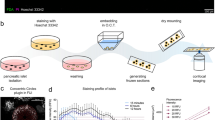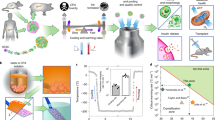Abstract
Background/purpose
Cryopreservation is necessary for the long-term storage of islet cells and to increase the practicality of clinical islet transplantation. Fetal bovine serum (FBS) supplemented with 10% dimethyl sulfoxide (DMSO) is generally used as a freezing medium for islet cells. However, FBS should ideally be avoided in cell culture and transplantation because of recent animal health problems, such as bovine spongiform encephalopathy and viral infections. The aim of this study was to develop a new serum-free freezing medium by examining the effectiveness of the silk protein sericin, which is produced by Bombyx mori.
Methods
Islets prepared from Lewis rats by collagenase digestion and Histopaque gradient centrifugation, followed by culture in medium containing 0.1% sericin for 3 days, were cryopreserved using 0.1, 0.5, 1, 2, and 5% sericin or FBS. DMSO (1, 4, 7, 10, and 15%) was added to the medium as a cryoprotectant. After thawing, on days 1, 4, 7, and 14, viable islets were counted in order to evaluate their survival. Insulin secretion was measured in vitro by a static incubation test on day 4. The in vivo function of cultured islets was tested by syngeneic transplantation. Islets were evaluated histologically and immunohistochemically after transplantation.
Results
There were no significant differences between freezing medium containing 1% sericin and that containing 10% FBS with regard to the survival rate of islets and stimulated insulin secretion. Following transplantation, islets rapidly reversed hyperglycemia and maintained normal glycemic control. In addition, the use of 7% DMSO as a cryoprotectant with sericin showed the same results as higher DMSO concentrations with FBS.
Conclusion
The present results showed that serum-free medium containing sericin is useful for both cryopreservation and cell culture.





Similar content being viewed by others
References
Kelly WD, Lilleihei RC, Merkel FK, Idezuki Y, Goetz FC. Allotransplantation of the pancreas and duodenum along with the kidney in diabetic nephropathy. Surgery. 1967;61:827–37.
Najarian JS, Sutherland DE, Matas AJ, Steffes MW, Simmons RL, Goetz FC. Human islet transplantation: a preliminary report. Transplant Proc. 1977;9:233–6.
Shapiro AM, Lakey JRT, Ryan EA, Korbutt GS, Toth E, Warnock GL, et al. Islet transplantation in seven patients with type 1 diabetes mellitus using a glucocorticoid-free immunosuppressive regimen. N Engl J Med. 2000;343:230–8.
Kenmochi T, Asano T, Maruyama M, et al. Clinical islet transplantation in Japan. J Hepatobiliary Pancreat Surg. 2009;16:124–30.
Rajotte RV, Stewart HL, Voss WA, Shnitka TK. Viability studies on frozen-thawed rat islets on Langerhans. Cryobiology. 1977;14:116–20.
Nakagawara G, Kojima Y, Mizukami T, Ono S, Miyazaki I. Transplantation of cryopreserved pancreatic islets into the portal vein. Tranplant Proc. 1981;13:1503–7.
Hunter N, Foster J, Chong A, McCutcheon S, Parnham D, Eaton S, et al. Transmission of prion diseases by blood transfusion. J Gen Virol. 2002;83:2897–905.
Morikawa M, Kimura T, Murakami M, Katayama K, Terada S, Yamaguchi A. Rat islet culture in serum-free medium containing silk protein sericin. J Hepatobiliary Pancreat Surg. 2009;16:223–8.
Furuya H, Kimura T, Murakami M, Katayama K, Hirose K, Yamaguchi A. Revascularization and function of pancreatic islet isografts in diabetic rats following transplantation. Cell Transplant. 2003;12:537–44.
Tze WJ, Wong FC, Tingle AJ. The use of hypaque-ficoll in the isolation of pancreatic islets in rats. Transplantation. 1976;22(2):201–5.
Korsgren O, Andersson A, Sandler S. Pretreatment of fetal porcine pancreas in culture with nicotinamide accelerates reversal of diabetes after transplantation to nude mice. Surgery. 1993;113(2):205–14.
Rajotte RV, Warnock GL, Coulombe MG. Islet cryopreservation: methods and experimental results in rodents, large mammals and humans. In: Van Schilfgaarde R, Hady M, editors. Transplantation of the endocrine pancreas in diabetes mellitus. Amsterdam: Elsevier; 1988. p. 125.
Murakami M, Satou H, Kimura T, Kobayashi T, Yamaguchi A, Nakagawara G, et al. Effects of micro-encapsulation on morphology and endocrine function of cryopreserved neonatal porcine islet-like cell clusters. Transplantation. 2000;70(8):1143–8.
Lakey JJ, Rajotte RV. Novel approaches to cryopreservation of human pancreatic islets. Transplantation. 2001;72:1005–11.
Kenmochi T, Asano T, Maruyama M, Saigo K, Akutsu N, Iwashita C, et al. Cryopreservation of human pancreatic islets from non-heart-beating donors using hydroxyethyl starch and dimethyl sulfoxide as cryoprotectants. Cell Transplant. 2008;17:61–7.
Fournier A. Quantitative data on Bombyx mori L. silkworm: a review. Biochimie. 1976;61:283–320.
Tsujimoto T, Takagi H, Takahashi M, Yamada H, Nakamori S. Cryoprotective effects of the serine-rich repetitive sequence in silk protein sericin. J Biochem. 2001;129:979–86.
Terada S, Nishimura T, Sasaki M, Yamada H, Miki M. Sericin, a protein derived from silkworms, accelerates the proliferation of several mammalian cell lines including a hybridoma. Cytotechnology. 2002;40:3–12.
Sasaki M, Kato Y, Yamada H, Terada S. Development of a novel serum-free freezing medium for mammalian cells using the silk protein sericin. Biotechnol Appl Biochem. 2005;42:183–8.
Author information
Authors and Affiliations
Corresponding author
About this article
Cite this article
Ohnishi, K., Murakami, M., Morikawa, M. et al. Effect of the silk protein sericin on cryopreserved rat islets. J Hepatobiliary Pancreat Sci 19, 354–360 (2012). https://doi.org/10.1007/s00534-011-0415-4
Published:
Issue Date:
DOI: https://doi.org/10.1007/s00534-011-0415-4




